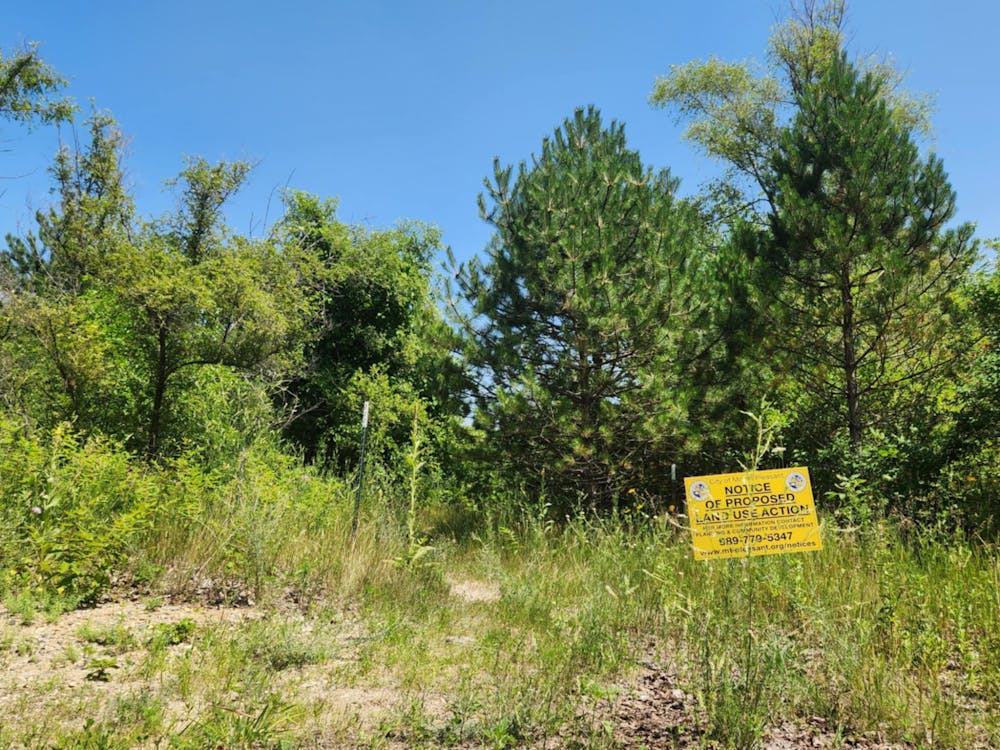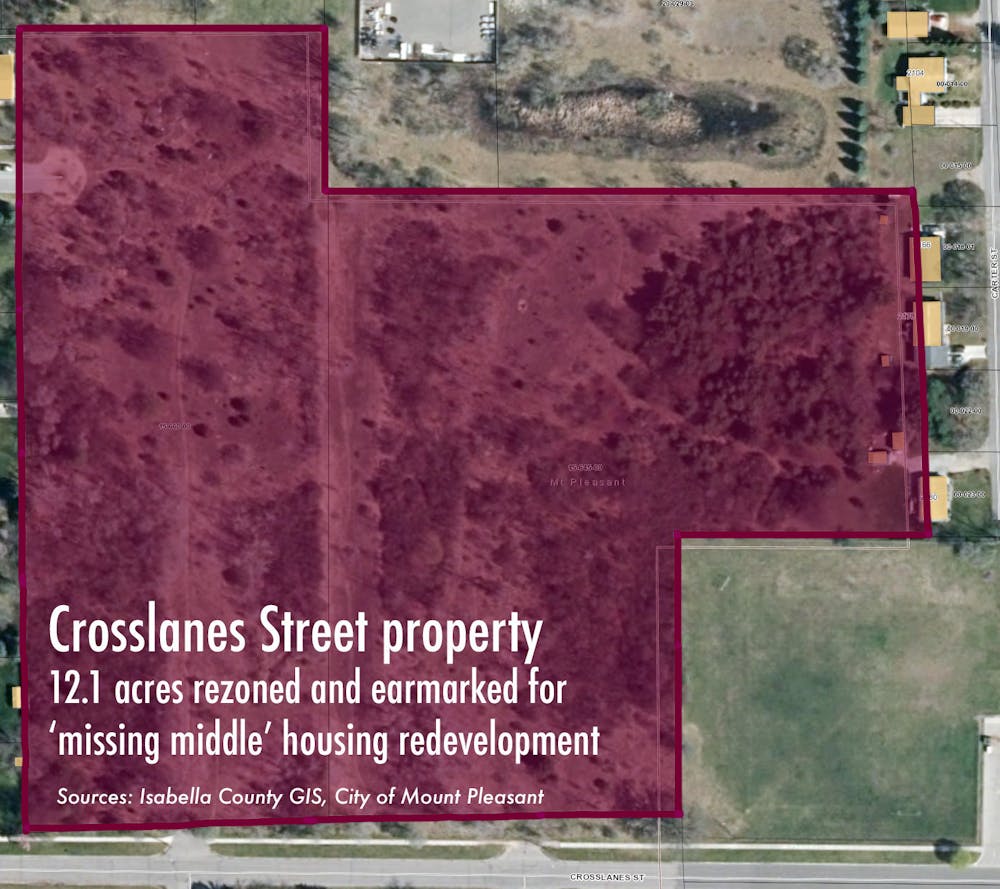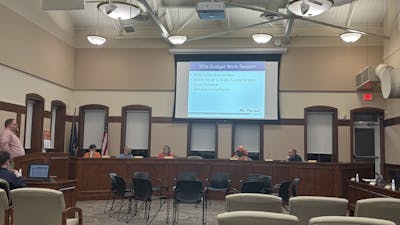An urgent need for new
City commission reviews, takes action on affordable housing

Mount Pleasant’s population is projected to grow by 585 households by 2029. The problem is, City Planning and Community Services Director Manuela Powidayko told the city commission Monday night, there is nowhere near sufficient affordable housing in town to support that growth.
“We’re talking 1,500 units we need to create,” she said at the start of a four-hour series of public hearings geared at growing the city’s so-called “missing middle” housing.
The four proposals were designed to support the development of more small-scale, multi-family houses like duplexes, fourplexes, cottage courts and townhomes. The industry standard, Powidayko said, is about 16 units per acre, which allows for development, generally without interrupting or changing the nature of the existing community.
“That’s the type of density that really encourages folks to leave their cars and walk to businesses,” she said. “It helps businesses want to relocate to where those residents exist.
“Increasing housing opportunities in Mount Pleasant is an economic strategy for all of us.”
Spurring the discussion were a proposed change to existing zoning laws that would allow for more dense development on single-acre parcels, and a trio of rezoning requests that could accommodate future residential growth on a vacant downtown lot and in existing residential areas on Chippewa and Crosslanes streets.
After hours of public hearings, the board voted to support:
- A rezoning of vacant land at the corner of East Michigan and South Pine streets to allow for mixed-use development that pairs street-level storefronts with upstairs apartments.
- Changes to the current zoning code to allow developers to build more than one main building on certain types of lots.
- The rezoning of a 12.1-acre property to allow phased affordable-housing development for renters and homeowners.
- Rezoning of an acre parcel to allow its owner to tear down the single-family home currently on the space and replace it with multiple four-plex apartments.
The only vote to not draw unanimous support was related to the one-acre parcel. Commissioner John Zang cast the sole dissenting opinion, saying it did not meet the criteria for rezoning.
Residents, community leaders and advocates jammed the commission chambers to share worries about the proposals, as well as to speak up on behalf of the need for affordable housing here.
Some worried that neighbors would lose their opportunity to provide feedback on what those developments should look like; others were concerned the proposals could change the nature of established neighborhoods. One resident spoke about the challenges of a young family living paycheck to paycheck in student-centric apartments – the only option available when he moved.
“I think a pocket neighborhood like that was shown is very nice and may be desirable,” resident Megan Moreno said. “Even if you said we are going to create a pocket neighborhood where all the residents will have a say in what their little neighborhood is like, what about the rest of us who are already in the surrounding neighborhood?
“If you make this move, we’re at a loss. … We have absolutely no say in what might fit in this space that could accommodate more people, without losing the residential character of the neighborhood.”
But Vice Mayor Maureen Eke, who, in addition to serving on the commission, is a professor at Central Michigan University, said she sees firsthand the challenges new colleagues face in finding a place to call home.
“Since I’ve been on the commission, this issue has been on the table,” she said. “We keep talking about making this place home for people who work here. The town is not going to be able to grow if people who work here cannot find housing.”
She said it is time for the board to make the critical decisions that will change that.
“It is necessary,” Eke said. “It is needed.”
“Increasing housing opportunities in Mount Pleasant is an economic strategy, for all of us.”
-- Planning and Community Services Director Manuela Powidayko
“Twelve acres would clearly support a very large apartment complex. As I have spoken with my neighbors … that’s the concern.”
-- Resident Keith MacDonald
What it means
The commission on July 14 reviewed a language change to the existing zoning code to allow denser development in areas zoned as CD-4, or general urban character districts. Prior to Monday’s vote, the rules said that builders in those districts could put one principal building – say a single-family home or duplex – on each lot.
But with the board’s blessing, that changed. Under the new rules, developers may build multiple buildings of up to three stories on single lots, without worries about strict density limits.
The purpose, city documentation showed, is to allow for the development of condominiums and other missing middle housing.
The switch was critical for two of the three land rezoning proposals considered the same night, and it raised red flags for residents who were worried it could result in unchecked development in spaces adjacent to established, residential communities.
Keith MacDonald lives near a 12.1-acre pair of parcels off Crosslanes Street. Affordable housing advocates and the property’s owners hope it could be subdivided and redeveloped into high-density, low-cost housing for low-and-middle-income renters and buyers.
Like many in attendance, MacDonald said he wasn’t opposed to affordable housing, but he was worried that the rezoning could open the parcel to what he described as “a runaway freight train.”
“Twelve acres would clearly support a very large apartment complex,” he said. “As I have spoken with my neighbors … that’s the concern.”
That resonated with Zang, who pointed to a highly contentious redevelopment proposal that would have opened 157.4 acres southwest of Crawford Road and Broomfield Street to a mix of residential, commercial and urban development. The commission batted down that proposal Dec. 9, before Zang was seated on the board.
“I’m suggesting we, as a commission, look to accommodate all those kinds of housing we spoke of earlier, but while we’re doing it, look to protect the neighborhoods where people have invested in their houses,” he said. “And maintain that opportunity for future homeowners so we can be a community that has all these diverse housing options.”
But Mayor Boomer Wingard countered that earth wouldn’t be moved without oversight. Before developments are approved, they must go through planning and permitting approvals, and Wingard said the community would hold not just the developers but the commission responsible for projects that are incongruent with their surrounding areas.
“My hope is to be able to create more spaces where people are able to come and stay in our community,” he said. “We are landlocked. There are very limited places where we can develop large, expansive housing, and the practicality of the matter does necessitate that we build more densely: That we create large, walkable neighborhoods.”
“I am empathetic,” Eke said. “Our goal is not to destroy neighborhoods. I understand that they need to be congruent with communities. I like that idea.
“But I am also troubled by the fact that, because we’re really stuck right now, we seem almost incapable of making a decision, (and) that worries me. Every time we come up here, we talk about this need, this need, but there’s no motion forward.”

Why it matters
The city is in desperate need of new, affordable housing stock, the commission heard Monday.
In fact, a recent survey of 47 community employers found that housing is a major concern when it comes to attracting and retaining qualified staff.
More than 67 percent of the employers said available housing stock was at the top of their needs list, according to the study conducted by Bowen National Research. Additionally, 50 percent of employers said a shortage of affordable rentals was a top issue, while 41 percent said the same about sale houses.
Would-be staffers commute into the city from elsewhere at a ratio of roughly six to one, Powidayko told the commission. And as Kati Mora, president and chief executive of the Middle Michigan Development Corp. pointed out, that means they are taking their hard-earned dollars with them at the end of the day.
“We have over 12,000 people commuting, and I believe it because I hear about it all the time,” she said. “There are a few communities that we hear … over and over again (where) our young professionals are choosing to live, and unfortunately, it’s not the city of Mount Pleasant.
“It’s not because they don’t love this community, they do,” she continued. “It’s because they cannot find the type of housing that they’re looking for.”
That means they are spending resources, time and finances somewhere else, Mora said.
“We want them to contribute not just as commuting workers, but as citizens of our communities,” she said.






